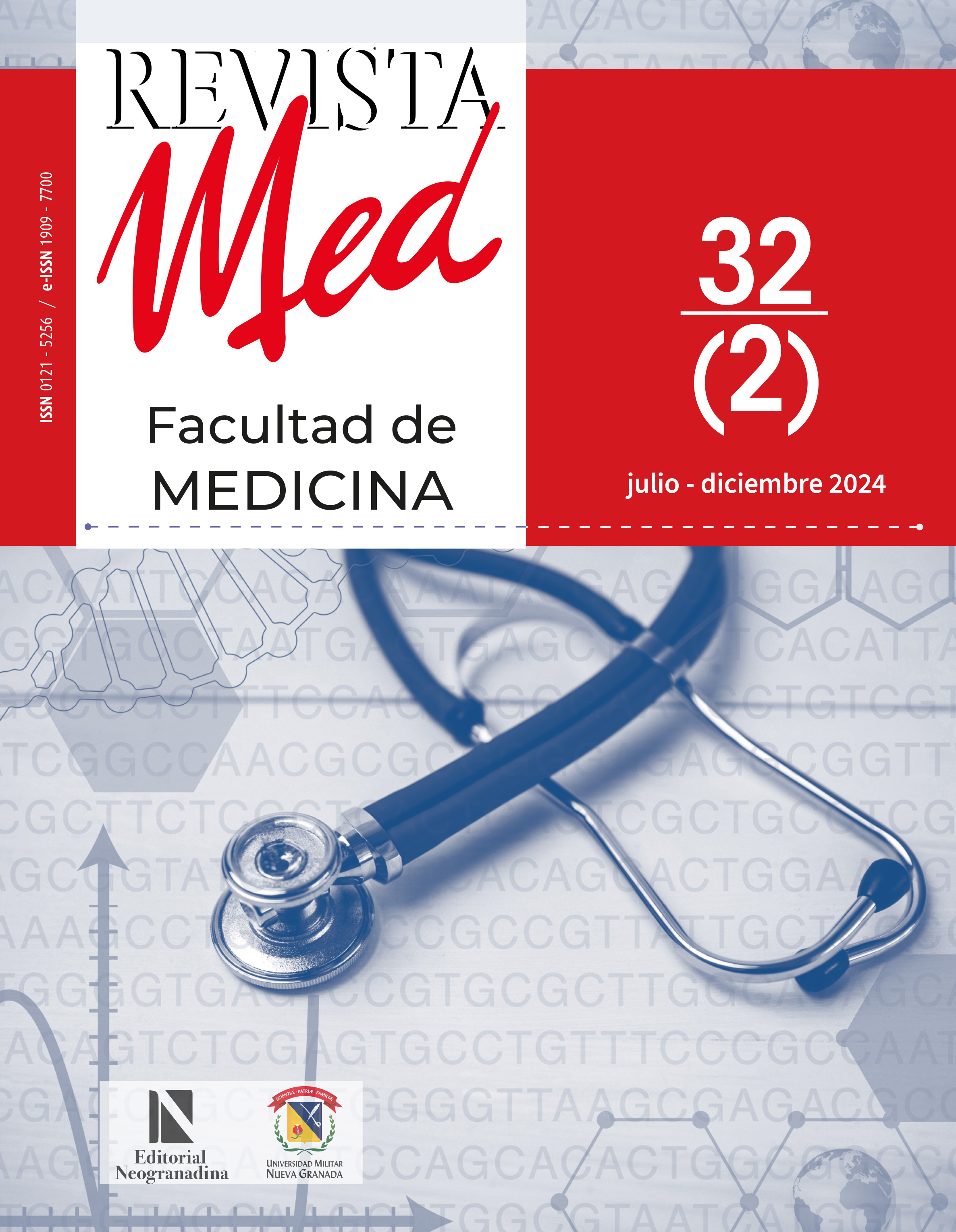Factors related to the prevalence of diabetic retinopathy
Abstract
Diabetes is a high-cost health condition that decreases the quality of life of those affected, and its complications, such as proliferative diabetic retinopathy, have become one of the leading causes of vision loss worldwide (1). Objective: To explore the sociodemographic, epidemiological, and clinical characteristics of the population with diabetes and the prevalence of diabetic retinopathy. Materials and Methods: This was a descriptive, cross-sectional, analytical study, utilizing secondary data sources. The reference population consisted of patients from the Valle de Aburrá and
southwestern Antioquia diagnosed with diabetes, who were part of the program “No more blindness due to diabetes” in 2018. Diabetic retinopathy was the dependent variable. The statistical tests had a 95% confidence level. Additionally, the incidence rate was calculated to measure associations, with a 95% confidence interval, and multiple logistic regression was used to explore variables contributing to the explanation of diabetic retinopathy. Results: A total of 564 patients participated. The highest incidences were observed in individuals aged 60 to 79 years (61.1%). Proliferative diabetic retinopathy was present in 2.3% (13) of them. Men had a 1.14 times higher prevalence of the disease (pr = 2.41, 95% ci: 1.30; 4.47) compared to women. Diabetic retinopathy was 53.16 times more prevalent in those
with macular edema (0 = 54.16, 95% ci: 18.85; 174.07) and 6.0 times higher in those with glaucoma (pr = 7.00, 9 5% ci: 1.29; 37.97). The use of hypoglycemic agents was associated with a 68% lower prevalence of diabetic retinopathy (pr = 0.32, 95% ci: 0.12; 0.82). Conclusions: Early identification and management with hypoglycemic agents could reduce the incidence of proliferative retinopathy and, therefore, decrease its progression to blindness.
Downloads
References
Ting DSW, Cheung GCM, Wong TY. Diabetic retinopathy: global prevalence, major risk factors, screening practices and public health challenges: a review: Global burden of diabetic eye diseases. Clin Experiment Ophthalmol.2016;44(4):260-77. https://doi.org/10.1111/ceo.12696
American Academy of Ophthalmology. Retina/Vitreous Panel. Preferred Practice Pattern® Guidelines. Diabetic Retinopathy;2017. www.aao.org/ppp
Jampol LM, Glassman AR, Sun J. Evaluation and care of patients with diabetic retinopathy. N Engl J Med. 2020;382(17):1629-37. https://doi.org/10.1056/NEJMra1909637
Vallejo-Mesa E, Rodríguez-Alvira FJ. Epidemiología de la retinopatía diabética y su relación con la diabetes. Rev.Colomb. Endocrinol. Diabetes Metab. 2016;3(1):12-15. https://doi.org/10.53853/encr.3.1.19
Teo ZL, Tham YC, Yu M, Chee ML, Rim TH, Cheung N, et al. Global prevalence of diabetic retinopathy and projection of burden through 2045: Systematic review and meta-analysis. Ophthalmology. 2021;128(11):1580-91. https://doi.org/10.1016/j.ophtha.2021.04.027
Hirai FE, Knudtson MD, Klein BEK, Klein R. Clinically significant macular edema and survival in type 1 and type 2 diabetes. Am J Ophthalmol. 2008 ;145(4):700-6. https://doi.org/10.1016/j.ajo.2007.11.019
Fong DS, Aiello L, Gardner TW, King GL, Blankenship G, Cavallerano JD, et al. Retinopathy in diabetes. Diabetes Care. 2004;27(Suppl 1):S84-87. https://doi.org/10.2337/diacare.27.2007.s84
Davis MD, Fisher MR, Gangnon RE, Barton F, Aiello LM, Chew EY, et al. Risk factors for high-risk proliferative diabetic retinopathy and severe visual loss: Early Treatment Diabetic Retinopathy Study Report #18. Invest Ophthalmol Vis Sci. 1998;39(2):233-52.
Lin KY, Hsih WH, Lin YB, Wen CY,Chang TJ.Update in the epidemiology, risk factors, screening, and treatment of diabetic retinopathy. J Diabetes Investig. 2021;12(8):1322-5. https://doi.org/10.1111/jdi.13480
Delgado JE, Porras A, Rico A, Pardo JM, Torres M. Análisis de situación de salud visual en Colombia 2016 [Internet]. Convenio 519 de 2015; 2016. https://www.minsalud.gov.co/sites/rid/Lists/BibliotecaDigital/RIDE/VS/PP/ENT/asis-salud-visual-colombia-016.pdf
Janghorbani M, Jones RB, Allison SP.Incidence of and risk factors for proliferative retinopathy and its association with blindness among diabetes clinic attenders.Ophthalmic Epidemiol. 2000;7(4):225-41. https://doi.org/10.1076/opep.7.4.225.4171
Trott M, Driscoll R, Pardhan S.Associations between diabetic retinopathy and modifiable risk factors: An umbrella review of meta-analyses. Diabet Med. 2022;39(6):e14796. https://doi.org/10.1111/dme.14796
Scanlon PH. Improving the screening of risk factors in diabetic retinopathy. Expert Rev Endocrinol Metab. 2022;17(3):235-43. https://doi.org/10.1080/17446651.2022.2078305
Vargas-Uricoechea H, Casas-Figueroa LÁ. An epidemiologic analysis of diabetes in Colombia. Ann Glob Health. 2015;81(6):742-53. https://doi.org/10.1016/j.aogh.2015.11.001
Villegas-Perrasse A, Abad SB, Faciolince S, Hernández N, Maya C, Parra L, et al. El control de la diabetes mellitus y sus complicaciones en Medellín, Colombia, 2001-2003. Rev Panam Salud Publica. 2006;20(6):393-402. https://doi.org/10.1590/S1020-49892006001100005
Kim K, Kim ES, Yu SY. Longitudinal relationship between retinal diabetic neurodegeneration and progression of diabetic retinopathy in patients with type 2 diabetes. Am J Ophthalmol. 2018;196:165-72. https://doi.org/10.1016/j.ajo.2018.08.053
Scanlon, PH, Aldington SJ, Stratton IM. Epidemiological issues in diabetic retinopathy. Middle East Afr J Ophthalmol. 2013;20(4):293-300. https://doi.org/10.4103/0974-9233.120007
Yau JWY, Rogers SL,Kawasaki R, Lamoureux EL,Kowalski JW, Bek T, et al.Global prevalence and major risk factors of diabetic retinopathy. Diabetes Care. 2012;35(3):556-64. https://doi.org/10.2337/dc11-1909
Talmadge K, Philipson L, Reusch J, Hill-Briggs F, Youssef G, Bertha B, et al. Standard of medical care in diabetes.ADA. 2018;41:150.
Nathan DM. The Diabetes control and complications trial/epidemiology of diabetes interventions and complications study at 30 years: Overview. Diabetes Care. 2014;37(1):9-16. https://doi.org/10.2337/dc13-2112
Rodríguez-Poncelas A, Miravet-Jiménez S, Casellas A, Barrot-De La Puente JF,Franch-Nadal J, López-Simarro F,et al. Prevalence of diabetic retinopathy in individuals with type 2 diabetes who had recorded diabetic retinopathy from retinal photographs in Catalonia (Spain). Br J Ophthalmol. 2015;99(12):1628-33. https://doi.org/10.1136/bjophthalmol-2015-306683
Ren C, Liu W, Li J, Cao Y, Xu J, Lu P. Physical activity and risk of diabetic retinopathy: a systematic review and metaanalysis. Acta Diabetol. 2019;56(8):823-37. https://doi.org/10.1007/s00592-019-01319-4
United States Surgeon General. The health consequences of smoking-50 years of progress: A report of the surgeon general. American Psychological Association; 2014. https://doi.org/10.1037/e510072014-001
González-Gutiérrez A, García-Mora A, Hernández-González M, González-Romero JM. Características clínicas de la retinopatía diabética en pacientes enviados al Servicio de Oftalmología. Rev. Med. Invest. 2013;1(2):68-73. https://www.elsevier.es/es-revista-revista-medicina-e-investigacion-353-pdf-X2214310613085530
Teliti M, Cogni G, Sacchi L, Dagliati A, Marini S, Tibollo V, et al. Risk factors for the development of micro-vascular complications of type 2 diabetes in a single-centre cohort of patients. Diab Vasc Dis Res.2018;15(5):424-32.https://doi.org/10.1177/1479164118780808
Pinto-Figueiredo L,Moita J, Genro V,Vinagre M, Laires R,Rosa MJ, et al. Diabetic retinopathy in a population of 1,302 insulin dependent diabetics (IDDM) diagnosed before 30 years of age. Int Ophthalmol.1992;16(6):429-37.https://doi.org/10.1111/ceo.12696
Chaturvedi N, Sjoelie AK, Porta M, Aldington SJ, Fuller JH, Songini M, et al. Markers of insulin resistance are strong risk factors for retinopathy incidence in type 1 diabetes. Diabetes Care.2001;24(2):284-9 https://doi.org/10.2337/diacare.24.2.284
Copyright (c) 2024 Revista Med

This work is licensed under a Creative Commons Attribution-NonCommercial-NoDerivatives 4.0 International License.











